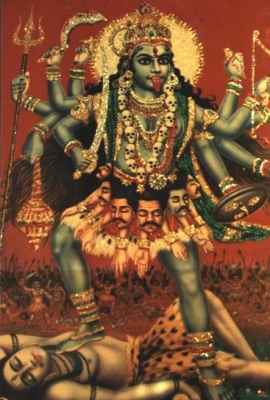|
|
|
KALI
Image used with permission.
Basic Description: Kali, onerepresentation of the goddess Devi. She is the goddess of violence andcruelty, but all of that force is said to be directed against evil. She isworshipped primarily by the Shaktism schoolof Buddhism and by the lower castes ofHinduism, especially in the Bengal region. Thereason that Kali is seen as cruel is because she is also known asPower-of-Time. Time eventually brings on the death of everything, and this iswhat Kali symbolizes and is in control of. In her depictions, she laughsbecause she knows that no one can escape the ultimate end of time, no matterhow hard they try. Kali is the only one that is beyond fear and Kali-worshipersbelieve that when they accept the harsh truths that Kali represents, that theytoo will be relieved of fear. Death to the ego is her primary concern: removingthe self-centered illusion held by most humans, thereby eradicating fear. Although Kali is such a vicious goddess, according to Ramakrishna (a 19 th century Bengali saint who had visions of Kali) she is actually the goddess oftender love, if one can see the “Divine Mother” beyond the eternal aspects ofTime. Her power is greater than any other god’s. Calcutta was named after the goddess Kalibecause she was the primary deity of the city. Alternate Names: Mahakali, Kala,Durga, Chandi History/Practices: Kali is worshipedthrough blood sacrifices, primarily animal. The cult of the Thagis, whoworshipped Kali, used to sacrifice human beings to the goddess up until thelate nineteenth century when it was prohibited by the British. The Englishword “thug," is derived from the name of this cult. Goats are still sacrificed toher daily at temples, especially in the well-known Kalighat temple in Calcutta. Iconography: Kali's body is typically shown as black or dark blue which symbolizes the abyss of time. She is typically naked withsagging breasts. She wears a necklace of skulls which symbolize theinseparableness of life and death, and a belt of severed limbs from the victims ofTime. She is sometimes pictured with a snake around her neck as well. Her face is in a grimace, with her blood-redtongue hanging out and down her lipless mouth with fangs on either side. Shehas four arms, two of which holding weapons and employed in the work of death, one pointing downwards and alluding to the universal chaos thatsurrounds her, and a last one which points upwards promising the regenerationof nature by way of a new creation. Kali is depicted either standing on atiger or, more often, standing or dancing on Shiva’s prone body. This gruesomeform of Kali is meant to frighten sinners into repentance and virtue. Mythology: Kali’s Taste forBlood: Kali is said to havedeveloped a taste for blood when she was asked to kill the demon Raktavija. When this demon’s blood fell to the earth, he made 1000 more of himself toappear with each drop. Thus, Kali has to drink every drop of Raktavija’s bloodbefore it reached the ground after piercing him with a spear and holding himabove her in order to defeat him. Riding Animal: Tiger Consort: Kali is considered to be one of Shiva’s many consorts, however she is not considered tobe a loving, faithful wife. The energy that she gives Shiva is destructive,with an all-pervading time aspect. Since her power is so great, she annihilatesthe power of the male counterpart. Sources: Collier’s Encyclopedia. “Kali”. New YorkP.F. Collier. 1995. Corduan, Winfried. NeighboringFaiths . Downer’s Grove, IL: InterVarsity Press. 1998. Dani é TheMyths and Gods of India. Rochester, VT:Inner Traditions International.1985. Encyclopedia Americana. “Kali”. Danbury, CT:Grolier, Inc. 2001. Moor, Edward. TheHindu Pantheon. Los Angeles:The Philadelphia Research Society, Inc. 1976.
|
|



